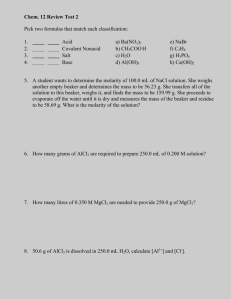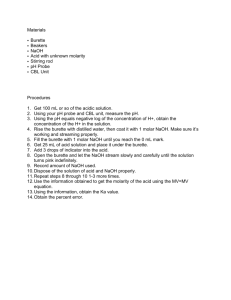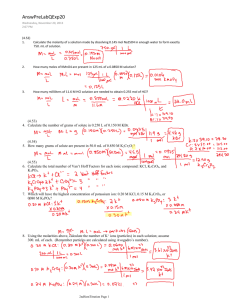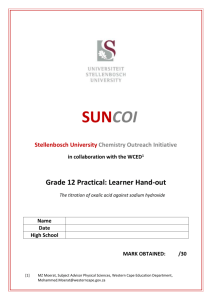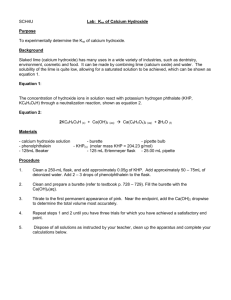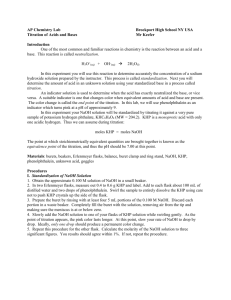Unit 5 Lab Titration Lab
advertisement
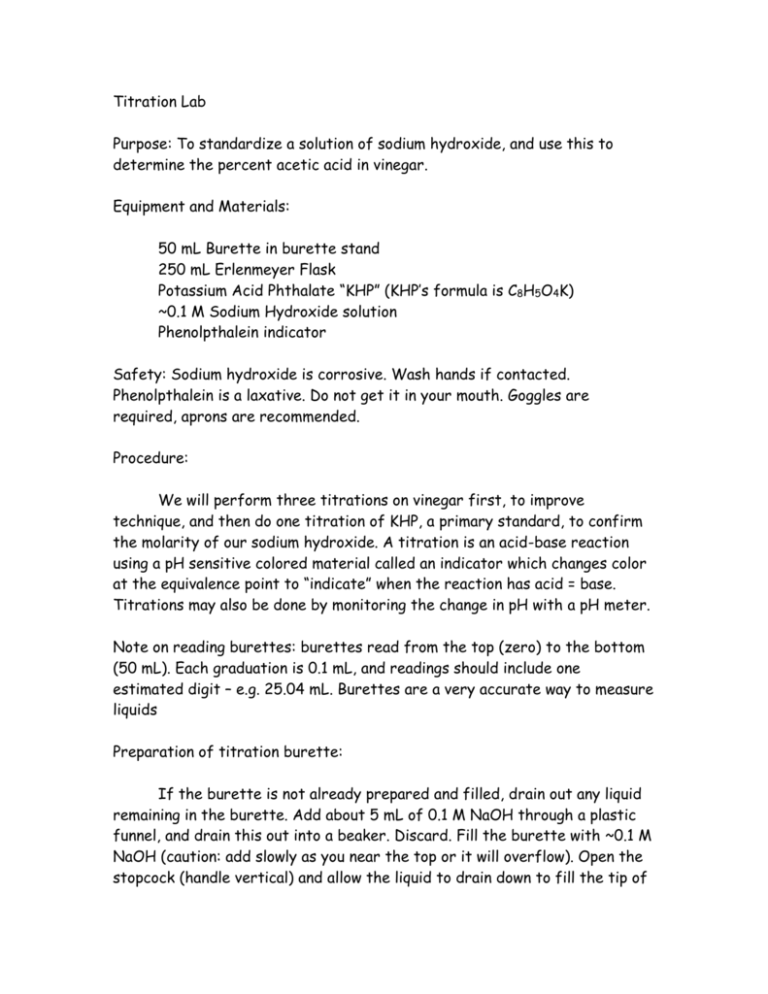
Titration Lab Purpose: To standardize a solution of sodium hydroxide, and use this to determine the percent acetic acid in vinegar. Equipment and Materials: 50 mL Burette in burette stand 250 mL Erlenmeyer Flask Potassium Acid Phthalate “KHP” (KHP’s formula is C8H5O4K) ~0.1 M Sodium Hydroxide solution Phenolpthalein indicator Safety: Sodium hydroxide is corrosive. Wash hands if contacted. Phenolpthalein is a laxative. Do not get it in your mouth. Goggles are required, aprons are recommended. Procedure: We will perform three titrations on vinegar first, to improve technique, and then do one titration of KHP, a primary standard, to confirm the molarity of our sodium hydroxide. A titration is an acid-base reaction using a pH sensitive colored material called an indicator which changes color at the equivalence point to “indicate” when the reaction has acid = base. Titrations may also be done by monitoring the change in pH with a pH meter. Note on reading burettes: burettes read from the top (zero) to the bottom (50 mL). Each graduation is 0.1 mL, and readings should include one estimated digit – e.g. 25.04 mL. Burettes are a very accurate way to measure liquids Preparation of titration burette: If the burette is not already prepared and filled, drain out any liquid remaining in the burette. Add about 5 mL of 0.1 M NaOH through a plastic funnel, and drain this out into a beaker. Discard. Fill the burette with ~0.1 M NaOH (caution: add slowly as you near the top or it will overflow). Open the stopcock (handle vertical) and allow the liquid to drain down to fill the tip of the burette completely, and bring the meniscus down onto the scale (it does not have to be on 0.00 mL). Wipe off any liquid on the burette, but don’t touch the very tip, since this would suck out liquid by capillary action. Titration of vinegar: In your 250 mL Erlenmeyer flask, obtain ~3 mL of vinegar from the burette on the front lab bench. Record the initial and final readings from the burette containing the vinegar in the data table, and calculate the actual volume taken by subtracting the smaller from the larger number. You will probably not draw out exactly 3 mL. Add about 50 mL of deionized water to the flask, and then 2 drops of phenolphthalein indicator. Slowly add NaOH solution from your burette, swirling the flask, until one drop turns the solution a persistent pink. Record your data. Titration of KHP: Weigh out about 0.2 g of potassium hydrogen phthalate, which we will use as the acid in place of vinegar. Record the actual mass, and transfer this solid completely to your rinsed Erlenmeyer flask. Add ~50 mL of deionized water and two drops of phenolphthalein indicator. Titrate. It should take less than half the amount of NaOH compared to your titrations of vinegar. Vinegar Data Final Reading, vinegar burette Initial reading, vinegar burette Volume of acid used Final reading, NaOH burette Initial reading, NaOH burette Volume of base used First run Second run Third Run KHP Data Only run Weight of KHP used Moles of KHP used (calc.) Final reading, NaOH burette Initial reading, NaOH burette Volume of hydroxide used Calculations (just follow along using the formulas given): Determining concentration of Sodium Hydroxide: Reminder: a “mole” is a chemist’s name for the formula weight of a compound, in grams. You know how to determine formula weight. So for example, 1 mole of H2O = 18 g. therefore 0.25 mole of H2O = 4.5 g (18 g/mole * 0.25 mole = 4.5 g) Molarity is the number of moles of a compound dissolved in 1.00 L of solvent. 36 g of HCl in a liter of solution is 1.0 M HCl; 3.6 g of HCl in one liter is 0.10M HCl. a) Calculate the moles KHP = (Weight KHP used)/(Formula weight of KHP). Remember “KHP” is not potassium, hydrogen and phosphorus, but is the organic formula given on page 1. So using the moles thus calculated: b) Use the relationship Moles KHP = (Molarity of NaOH) x (Volume of NaOH in Liters) to determine the actual molarity of the NaOH you have been using. With the molarity as the unknown, solve for molarity. Now using this experimentally determined NaOH molarity, determine the molar concentration of acetic acid in vinegar with the following relationship: c) (Molarity of NaOH) x (Volume of NaOH) = (Molarity of CH3COOH) x (volume of vinegar) Calculate each run separately. Here volume can be in milliliters. Determining % acetic acid in vinegar: d) (Molarity of acetic acid) x 0.1 x (Formula weight of CH3COOH) = % acetic acid Calculate each run separately. Lab report: Title Purpose Procedure Data (attach Dr. Maynes’ data form if neat) Equations (write balanced equations for neutralization of KHP and of CH3COOH) Calculations (showing how you got molarity of NaOH and CH3COOH, and % CH3COOH) Conclusions (What were possible sources of inaccuracy/”error”? Why did we multiply by 0.1 in determining % from molarity? What is your grand average for % acetic acid? What is your range?)
